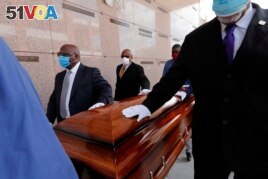15 June 2021
Jerry Ramos spent his final days in a California hospital, connected to an oxygen machine to help him fight COVID-19. But his 3-year-old daughter was in his thoughts.
Ramos wrote on Facebook, "I have to be here to watch my princess grow up." He did not live to see it. He died on Feb. 15 at the age of 32.
The Mexican-American restaurant worker became one of the 600,000 Americans who have died from the virus so far. His death also represented the pandemic's effect on the racial and ethnic inequalities in the U.S.
During the first wave of deaths in April 2020, the virus went through cities with large Black populations in the Northeast, as well as Detroit, Michigan and New Orleans in Louisiana. Black Americans were hit the hardest during that time.
During a second increase last summer, high cases of infection in the states of Texas and Florida caused Hispanics to die at the highest rate.
And during the third winter increase, the worst of all, cases were high across the entire country. The weekly death rates narrowed so much that whites were the worst off. And Hispanics closely followed.

In this April 22, 2020, file photo, pallbearers, who were among only 10 allowed mourners, walk the casket for internment at the funeral for Larry Hammond, who died from the coronavirus, at Mount Olivet Cemetery in New Orleans.(AP Photo/Gerald Herbert, File)
Higher death rates for Blacks, Hispanics
Now, the virus has slowed and more people are getting vaccinated. But Blacks and Hispanics continue to die at higher rates than other groups.
An Associated Press study shows that, overall, Black and Hispanic Americans have less access to medical care and are in poorer health. They have higher rates of health conditions like diabetes and high blood pressure.
Blacks and Hispanics are more likely to have jobs that require their physical presence at work. They are less able to work from home. They are also more likely to live in larger households, where family members may spread the virus.
Black Americans account for 15 percent of all COVID-19 deaths where race is known. Hispanics represent 19 percent, whites 61 percent and Asian Americans 4 percent. Those numbers are close to each groups' share of the U.S. population. But a closer look at age shows a clearer picture of inequality.
Blacks and Hispanics are younger on average than whites. So it would make sense that they would die at lower rates from a disease that severely affects older populations. But that is not what is happening.
The Centers for Disease Control and Prevention (CDC) looked at death rates, adjusting for population age differences. The CDC estimates that Native Americans, Hispanics and Blacks are two to three times more likely than whites to die of COVID-19.
The AP research also found that Hispanics, like Ramos, are dying at much younger ages than other groups.
Thirty-seven percent of Hispanic deaths were of those under 65, versus 12 percent for white Americans and 30 percent for Black people. Hispanics between 30 and 39 have died at five times the rate of white people in the same age group.
Public health experts say the nation needs to look at these differences.
Dr. Clyde Yancy is with Northwestern University's medical school. "If we want to respect the dear price that 600,000 people have paid, don't return to normal. Return to something that is better than what was," he said.
Blacks and Hispanics are also behind whites when it comes to vaccination rates, said Samantha Artiga of the Kaiser Family Foundation.
Experts say this is due to several factors. Many Black Americans distrust the medical profession because of a history of discriminatory treatment. Among Hispanics, there is a fear of deportation and a language barrier for many.
Money could be a problem, Artiga said. "Losing a day or two of wages can have real consequences for your family. People are facing tough decisions like that."
With incomplete data, it is less clear who is dying now. But a racial gap appears to be growing again. In the state of Michigan, Black people are 14 percent of the population. But they have accounted for 25 percent of the 1,064 deaths reported in the past four weeks. Similar gaps were seen in Florida and Pennsylvania.
On Monday, U.S. President Joe Biden said that while new cases and deaths are dropping in the U.S., "there's still too many lives being lost." He added, "now is not the time to let our guard down."
I'm Dan Novak.
Carla K. Johnson, Olga R. Rodgriguez and Angeliki Kastanis reported this story for The Associated Press. Dan Novak adapted it for VOA Learning English. Hai Do was the editor.
______________________________________________________________
Words in This Story
access– n. a way of being able to use or get something
adjust– v. to change (something) in a minor way so that it works better
dear– adj. loved or valued very much
factor– n. something that helps produce or influence a result : one of the things that cause something to happen
deport – v. to force (a person who is not a citizen) to leave a country
consequence – n. something that happens as a result of a particular action or set of conditions
let (one) guard down – idiom. to lower one's level of caution or carefulness